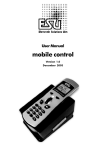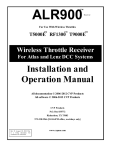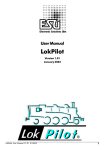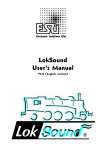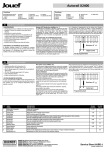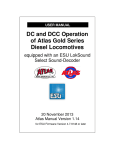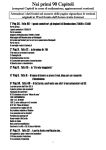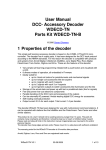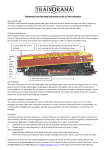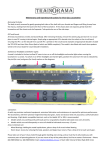Download User`s Manual - Broadway Limited Imports
Transcript
User's Manual Part I: For Precision Craft Models locomotives equipped with the LokSound Operation and Sound System Part II: For Precision Craft Models DCC Ready locomotives without sound Operator's Manual for Precision Craft Models LokSound V3.5 Equipped Locomotives 1 Contents PART I 1. Introduction ................................................................................................................................................................................... 3 2. Set-up and Installation.................................................................................................................................................................. 3 2.1.1 Supported Operating Modes ............................................................................................................................................... 3 2.1.1 Analog Operation................................................................................................................................................................... 4 2.1.2. Digital Operation.................................................................................................................................................................... 4 3. Programming of Parameters for Digital Operation............................................................................................................... 4 3.1 Programming with DCC-Systems (Lenz, ZIMO, Intellibox)................................................................................................. 5 3.1.1 Which Settings may be changed? ........................................................................................................................................ 5 3.1.2 How to set parameters......................................................................................................................................................... 5 3.1.3 Decoder Reset ....................................................................................................................................................................... 5 3.2 Programming with Märklin® 6021 ........................................................................................................................................... 5 3.2.1 How to program using the 6021......................................................................................................................................... 5 4. Additional Information................................................................................................................................................................. 8 5. Service - Support and Assistance ............................................................................................................................................. 8 PART II (For owners of DC Only, DCC Ready Locomotives) 1. Operating your Conventional DC locomotive.......................................................................................................................9 2. Upgrading your Conventional DC locomotive to DCC........................................................................................................9 C ongratulations on your new purchase of a superior quality model railroading product from Precision Craft Models! Your new locomotive has been designed to exacting standards and utilizes the latest electronics available today, giving you the maximum value for your model railroading dollar. Your locomotive is ready to use right out of the box, but please take a moment to peruse this User's Manual for maximum enjoyment of your new locomotive. Thank you for choosing Precision Craft Models! Copyright 2006 Precision Craft Models, Inc. Electrical characteristics and dimensions are subject to change without prior notice. All rights reserved. Precision Craft Models, Inc. may not be held responsible for any damage or consequential loss or damage caused by inappropriate use of the product, abnormal operating conditions, unauthorized modifications to the product, etc. Not suitable for children under 3 years of age. Inappropriate use may result in injury due to sharp points and edges. Märklin® is a registered trademark of the company Gebr. Märklin® und Cie. GmbH, Göppingen, Germany. 2 Operator's Manual for Precision Craft Models LokSound V3.5 Equipped Locomotives Introduction 1. Introduction The LokSound V3.5 decoder represents a key component of your newly acquired locomotive. The LokSound V3.5 circuitry is responsible for all drive control functions as well as sound functions of your new Precision Craft Models locomotive: • Motor control forwards and reverse • Control of all lighting functions • Smoke Unit Functions (only if applicable) • Sound and special sound functions The LokSound V3.5 decoder supports the most commonly used control systems: Analog operation with DC or AC, digital operation with Märklin® digital (Motorola-Format) or DCC-Systems (i.e. Lenz, NCE, Digitrax, etc.) The locomotive is preset at the factory for immediate operation (the LokSoundV3.5 decoder recognizes the required operating mode automatically). Nevertheless we kindly ask you to first read these instructions before you set this locomotive onto a powered track. Chapter 2 provides an overview of the supported operating modes and which functions may be activated in which mode (some functions can only be utilized in digital operation). If you intend to change the factory settings (i.e. the address, or the sound volume), we strongly recommend to study chapter 3 first. There you will find out about all parameters of the LokSound V3.5 decoder and how to set them with the commonly available digital command stations. You will also find instructions of how to reprogram the factory settings. Chapter 4 is written for expert users who want to know more about the LokSound V3.5 decoder and its technology. Important Warning: • This LokSound V3.5 decoder is designed for use in this Precision Craft Models locomotive only. • Do not expose to wet and humid conditions. • Always disconnect the circuit when servicing the decoder. Please install the body shell before appling voltage. • Make sure that no blank wire ends come into contact with the locomotive. • Make sure that no wires are squeezed or cut by the model's transmission parts when reassembling the locomotive. • Handle the speaker(s) with extreme care: Do not touch the membrane or apply pressure! 2. Set-up and Installation The locomotive can be operated straight out of the box. The selection of the appropriate operating mode happens automatically. You do not have to change any parameters . 2.1 Supported Operating Modes The locomotive may be operated on conventional (analog) as well as on digital layouts. The number of available functions varies depending upon the mode: Analog Operation Motor control forwards-stop-reverse Directional lighting & Steam/Diesel sound (can be disabled using CV 13, Bit 0), Whistle/Horn, Bell, Doppler Effect, Squealing Brakes and an auxiliary sound or operation (using the DCMaster Analog Control Module. Digital Operation Motor control forwards-stop-reverse Digital address: “03” (DCC and Märklin Motorola) Should you still have questions please study Chapter 5, which tells you how to obtain support and assistance. We wish you lots of fun and enjoyment with your new Precision Craft Models locomotive! For a list of DCC functions, please refer to the DCC function guide sheet that was included with your locomotive. Operator's Manual for Precision Craft Models LokSound V3.5 Equipped Locomotives 3 Analog and Digital operation 2.1.1 Analog Operation Any DC power pack (i.e. from MRC, ROCO, etc) or AC controller (i.e. from Märklin®, Titan) is suitable for analog operation. Please note, that not all electronic controllers which supply pulsed DC (PWM Operation) guarantee 100% reliable operation. Since there are so many different products commercially available we can only recommend to carry out your own tests. DC Operation DC Operation is possible without any difficulties, however, there is one difference compared to operating DC locomotives without decoder: the voltage required to start movement is notably higher. To operate your locomotive in conventional DC mode, simply apply power using the rheostat and change directions using the direction switch. DC users should acquire and install the Precision Craft Models DCMaster Analog Control Module to gain access to sound features like the whistle/horn, bell, Doppler effect, Auxiliary Sound and Operation functions as well as DC programming and volume adjustment with just a touch of a button. AC Operation (Märklin®) This works in the same way as you know it from other models: Speed control is achieved through turning the control knob. Change of direction is achieved by pushing the control knob beyond the stop position towards the left. The locomotive must have come to a complete standstill before you may activate the change of direction command. Never try to change direction while the locomotive is still moving. 2.1.2. Digital Operation For prototypical operation we recommend the use of a digital command control system. Besides the fact that special functions are only available in digital mode, the LokSound V3.5 decoder offers silent, load compensated motor control. The LokSound decoder “understands” commands from the Märklin® 6021 command station based on the widely used Motorola-Protocol as well as from DCC-systems from Digitrax, NCE, CVP, MRC, 4 Lenz, ZIMO and Uhlenbrock, which are based on the NMRA-DCC-Protocol. Therefore it does not matter which commercially available system you use since LokSound V3.5 decoders auto-detect the protocol and then operate accordingly. Nevertheless, there are considerable differences between the various commercially available digital systems. Therefore the remainder of chapter 2 focuses purely on driving the locomotive with different systems and also to highlight typical problems and limitations. Please read Chapter 3 if you intend to change the factory settings of the LokSound V3.5 decoder. Digital Operation with DCC-Systems The LokSound V3.5 Digital Decoder can be run with any system that conforms to DCC. The automatic speed step detection has been tested with the following appliances: NCE, Digitrax, ROCO Lokmaus 2, Uhlenbrock Intellibox, Lenz Digital plus, ZIMO MX1. The detection does not function when operated with Lenz Digital plusV3.0 if you wish to run 14 speed steps. Use 28/128 speed steps. Each time that the LokSound V3.5 Digital Decoder receives current (i.e. after the system is switched on) and the light is switched on it tries to detect the speed steps settings. If you switchover the speed steps settings during operation you must briefly switch off the current supply to the locomotive so that the automatic mode functions as desired. The detection takes up to 30 seconds. Functions F1 to F8 allow you to activate the various sound effects when using DCC-systems Digital Operation with Märklin® Digital (6021) The locomotive will operate reliably with the Märklin® 6021 command station. However, the LokSoundV3.5 decoder offers a special feature: Besides the normal locomotive address (factory default: 03) the decoder „listens“ also for the next address. If you use this address with your 6021, you can activate the functions F5 to F8 by pressing F1 to F4. To enable the second Motorola -address, you may change CV49, Bit 3 (see chapter 3). Please write a value of „27“ in CV49. 3. Programming Parameters for Digital Operation Even though the LokSound V3.5 decoder has been Operator's Manual for Precision Craft Models LokSound V3.5 Equipped Locomotives Programming using DCC adapted optimally to the locomotive you may adapt many of the characteristics to suit your own preferences. All parameters are internally stored as numbers (values) in the LokSound V3.5 decoder. According to the NMRA-DCC Standards all parameters are stored in memory cells called CV’s (Configuration Variable). Whenever you change a CV the decoder will adjust its behavior accordingly. All CV’s may be changed by programming with the aid of a digital command control station (or in DC with the DCMaster). Depending on which type of command station you have the procedure may vary: • If you use a DCC command station i.e. Lenz Digital plus, ZIMO MX1 or Uhlenbrock Intellibox, please refer to Chapter 3.1. • Users of the Märklin® 6021 find relevant information in Chapter 3.2. • If you prefer to change the settings of the locomotive by using the LokProgrammer by ESU we recommend to first study Chapter 5. There you will find out many important details. 3.1 Programming with DCC-Systems (Lenz, ZIMO, Intellibox) Any digital command station, which offers the programming features according to the NMRA-DCC specification, can be used to program the LokSound V3.5 decoder. Depending on the type and features of your command station you may be able to read and write CV’s (Lenz LH100, Uhlenbrock Intellibox, ZIMO MX1, Arnold digital) or you may only be able to write CV’s (Lenz digital compact, Lenz LH200, ROCO LokMaus II). to deactivate the analog recognition CV29 since it is not advisable to activate the Märklin® brake section and analog operation at the same time. Therefore you write 0 + 0 + 0 + 0 = 0 in CV29. 3.1.2 How to set parameters We cannot provide a general instruction for programming with all DCC-systems since there are so many differences in the way they operate. You should always try to use the DCC direct mode if possible (byte-weise CV-programming with Uhlenbrock) or the DCC paged mode. The relevant information for users of the Intellibox are found in Chapter 9 “programming” of the technical manual. You should take particular notice of Chapter 9.5 “Programming of DCC-decoders”. Programming should always be done in “CV-programming byteweise”. 3.1.3 Decoder Reset You can reinstate the factory settings at any time if you cannot get any further: Set CV8 to value 8 for automatic resetting Lenz digital plus There are various software versions available of the Lenz digital plus command station.You need firmware version 2.3 or higher in order to program LokSound V3.5 decoders. Contact Lenz for more details regarding upgrades of older versions. 3.1.1 Which Settings may be changed? 3.2 Programming with Märklin® 6021 Figure 1 on page 6/7 shows the adjustable parameters. With the Märklin® command station you cannot modify standard CVs as it does not comply with the NMRA DCC standards. CV’s 29, 49, 50 and 51 are different to other CV’s: Generally you would write a value into a CV whereas for CV29, 49 ,50 or 51 the actual value has to be calculated. This depends on the desired settings: First you decide which option should be switched on or off. In the column value you find two numbers for each option. If the option is switched off the value is zero otherwise the value is any number between 132. Add all the values for each option to get the total which has to be written into the CV. Example : You want to activate the Märklin® brake section while load compensation remains active. Therefore you write (1) in CV51. Now you have However, the most important CVs of LokSound V3.5 decoders may be changed . 3.2.1 How to program using the 6021 To get into programming mode: Press the "stop" and "go" keys simultaneously on 6021 to activate a reset (or pull the plug of the power pack).To switch off the track voltage, press the "stop" key. Enter the current decoder address (alternative "80"). •Activate the change of direction feature (turn the control knob far left until you hear a "click"), hold the knob in position and press the "go"-key. Operator's Manual for Precision Craft Models LokSound V3.5 Equipped Locomotives 5 Figure 1: Programming table - List of most important CVs. CV Name Description Range 1 Locomotive address Motorola-address of locomotive 1 - 127 03 2 Start voltage Sets the minimum speed of the locomotive 0 - 75 03 3 Acceleration This value multiplied by 0.869 is the time from stop to maximum speed 0 - 64 08 4 Deceleration This value multiplied by 0.869 is the time from maximum speed to stop 0 - 64 06 5 Maximum speed Maximum speed of locomotive 0 - 64 57 6 Vmid Medium speed of locomotive 0 - 64 22 Status of functions F1 to F8 in analog mode Bit Description 0 function F1 1 1 function F2 2 2 function F3 4 3 function F4 8 4 function F5 16 5 function F6 32 6 function F7 64 7 unction F8 128 long address of locomotive CV 17 contains byte with higher value (Bit 6 and Bit 7 must always be active), CV18 contains byte with lower value. Only active when function in CV 29 is switched on. (see below) 0-255 value 01 192 999 192 13 Analog mode F1-F8 17 Extended 18 locomotive address 29 Configuration register 49 Extended configuration The most complex CV within the DCC standards. This register contains important information, which is only relevant in DCC operation. Bit function value 0 Reverse direction of travel (forward becomes reverse) normal direction 0 reversed direction 1 1 speed steps (only for DCC operation) 14 speed steps 0 28 or 128 speed steps 2 2 analog operation analog operation switched off 0 analog operation permitted 4 4 selection of speed curve speed curve through CV 2,5, 6 0 speed curve through CV 67 - 96 16 5 selection of locoaddress (only for DCC operation) short addresses (CV 1) in DCC operation 0 long addresses (CV 17 + 18) in DCC operation 32 Additional configuration options Bit description 0 1 3 4 6 load control activated Motor PWM (0=15 kHz, 1= 30kHz) Enable second Motorola address DCC automatic speed step detection Default 04 19 value 1 2 8 16 Operator's Manual for Precision Craft Models LokSound V3.5 Equipped Locomotives Figure 1: Programming table - List of most important CVs. CV Name Description Range 50 Analog mode Selection of desired analog mode Bit description 51 Brake mode 0-3 03 value 0 AC analog mode AC analog mode off AC analog mode on 0 1 1 DC analog mode DC analog mode off DC analog mode on 0 2 Selection of desired brake mode Bit description Default 03 value 0 Märklin® brake mode Märklin® brake mode off Märklin® brake mode on 0 1 1 Zimo brake mode Zimo brake mode off Zimo brake mode on 0 2 2 not used 3 Lenz DC brake mode Lenz brake mode off Lenz brake mode on 63 sound volume 121 Whistle sound volume 0 8 0 = low, 64 = max. volume 0 = low, 64 = max. volume •The Loksound decoder is now in programming mode (the headlights flash as an indicator). • Enter the CV number you want to change. Make sure you always enter a two digit number (e.g. "01" and not "1") •To confirm any entry turn the knob to the far left (change of direction feature). • Now enter a new value for the CV as a two digit number. •Turn the knob to the far left to confirm. (the headlights are on for about 1 second). • Enter further CVs you want to modify. • Exit the programming mode by selecting CV "80" or switch the track voltage off and on (press "stop"-key and then "go"-key on 6021). Note that you may only enter values 01 to 80 with the 6021.Value "0" is missing, enter instead "80". 4. Additional Information The LokSound V3.5 decoder installed in your locomotive offers more options than described in this manual. However, they have already been optimally 01 - 64 01 - 64 64 64 adjusted to the model and thus there is no need to adjust them. Expert users can use the information as outlined in the comprehensive “LokSound V3.5 Installation and Operating Manual”. You can download this manual free of charge from the ESU website http://www.loksound.de under the section “instructions” (“Anleitungen”). For easy programming of the numerous options offered by the LokSoundV3.5 decoder we recommend to use the “LokProgrammer”. With the aid of this interface and the software that is supplied with the LokProgrammer you can easily adjust all parameters on your PC. System requirements are Windows 2000 or XP. No need for studying tables and calculating values – everything can be done by way of mouse clicks while you have all important information readily available on screen. Please note:you require at least the Lokprogrammer Nr. 53451 to be able to program your Precision Craft Models locomotive. An update is available from the ESU website http://www.loksound.de Operator's Manual for Precision Craft Models LokSound V3.5 Equipped Locomotives 7 Support & Help 5. Service - Support and Assistance Your first contact should always be the model train or hobby shop where you have purchased your Precision Craft Models locomotive. Your dealer is your competent partner for all your questions regarding model trains and also your Precision Craft Models locomotive. You may also choose to contact Precision Craft Models directly. For enquiries please use either email or fax (don’t forget to provide your own fax-no.) and we will reply within a few days. PCM also offers telephone based technical assistance. However, please use telephone based support only in case of complex enquiries that cannot be dealt with by email or fax. Phone support is often very busy and you may encounter delays. Also check the PCM website for more information, http://www.precisioncraftmodels.com. You will find many hints regarding FAQs and even feed back from other users. by phone: 386-615-1912 Monday to Friday from 8am to 5pm EST 8 by Fax : 386-615-1720 by email: [email protected] Internet: www.precisioncraftmodels.com Operator's Manual for Precision Craft Models LokSound V3.5 Equipped Locomotives PART II - For owners of DC only, DCC Ready Locomotives 1. Operating your Conventional DC Locomotive Operation of your conventional DC locomotive is simple. To operate, you will need a conventional DC power pack. Speed is controlled by the rheostat on the power pack and the direction is controlled by the direction switch on the power pack. Users who own both conventional DC locomotives as well as sound equipped locomotives will note that the voltage required to start a conventional DC locomotive in motion is substantially lower than a sound equipped unit. 2. Upgrading your Conventional DC Locomotive to DCC Your Precision Craft Models DCC ready locomotive can be upgraded to DCC using the onboard DCC socket. You may install any NMRA compliant DCC decoder which fits inside the space confines of your particular model. Simply plug the user-supplied DCC decoder into the onboard DCC socket on the locomotive (or tender) motherboard. Certain models have specifically tailored sound & DCC upgrade kits which include a DCC decoder, speakers and necessary wiring. Please check the PCM website www.precisioncraftmodels.com for more information. Or check with your local hobby dealer. Precision Craft Models, Inc. 4 Signal Ave., STE A Ormond Beach, FL 32174 www.precisioncraftmodels.com Operator's Manual for Precision Craft Models Conventional DC Locomotives










